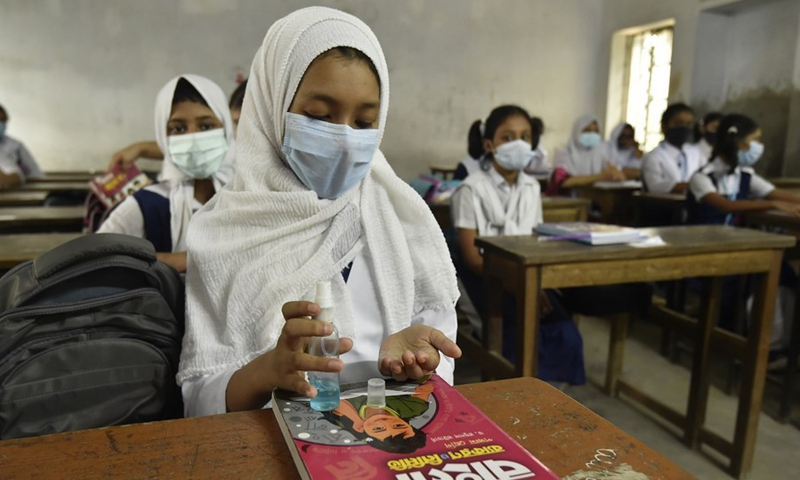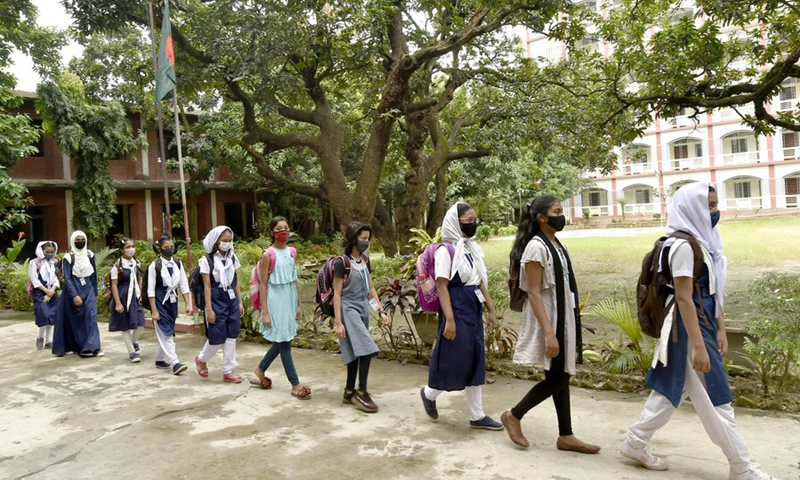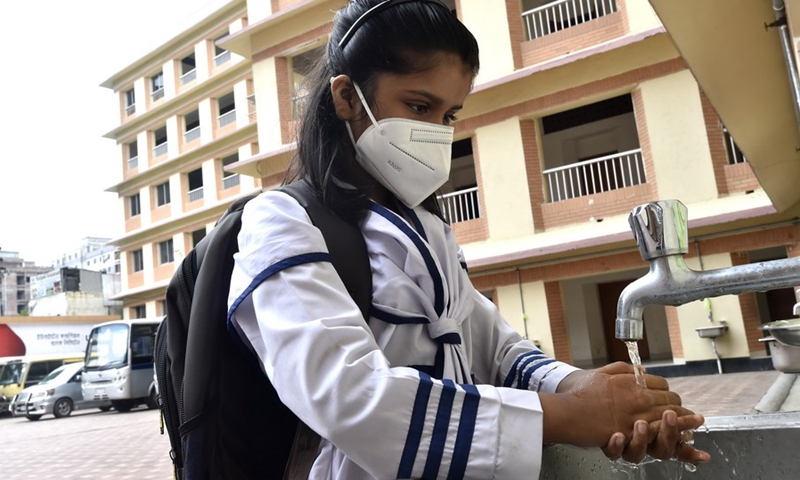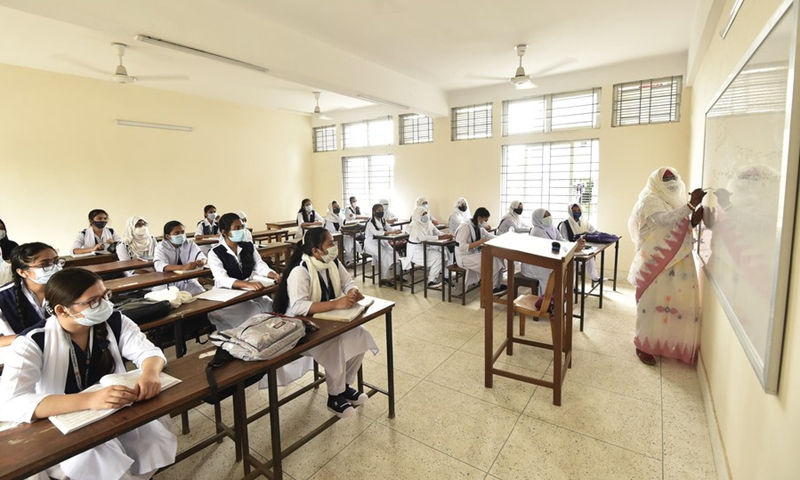
A student disinfects her hand at a school in Dhaka, Bangladesh, Sept. 14, 2021.(Photo: Xinhua)

Students line up to enter classrooms at a school in Dhaka, Bangladesh, Sept. 14, 2021.(Photo: Xinhua)

A student washes her hands before entering a school in Dhaka, Bangladesh, Sept. 14, 2021.(Photo: Xinhua)

A teacher gives a lesson at a school in Dhaka, Bangladesh, Sept. 14, 2021.(Photo: Xinhua)
The education of 37 million children in Bangladesh and about 800 million children in Asia, including South Asia, Southeast Asia and East Asia, has been disrupted due to school closures since the onset of the COVID-19 pandemic in early 2020, according to a report released Tuesday by UNICEF and UNESCO.
The "Situation Analysis on the Effects and Responses to COVID-19 on the Education Sector in Asia" report highlights the continued impact of the pandemic on children's education and features various regional governments' programs and initiatives to respond to it.
At a time of the year when children traditionally should have returned to school from annual holidays, the report urges governments to reopen schools as soon as it is safe to do so.
In some countries, schools have been closed throughout the entire pandemic to date. In Bangladesh, schools have been shut down since March 2020 until Sept. 12 this year when they reopened again.
Even now, as the world enters the last quarter of 2021, many children are facing an unprecedented second year of school closures as new variants of the coronavirus spread across the region. The associated consequences of such continuous school closures are staggering.
"We cannot overlook the impact that the disruption of education services has had on children, particularly the most vulnerable. When schools remain closed, children miss out on the biggest opportunity to learn and develop to their full potential," stated Marcoluigi Corsi, UNICEF regional director for East Asia and Pacific.
"The future of an entire generation is at stake; therefore, we need every effort to ensure a safe reopening of schools as soon as possible. Otherwise, the learning loss will be difficult to overcome."
While countries across Asia are taking actions to provide students with distance learning, a UNICEF-supported study by the Campaign for Popular Education showed that two out of three pre-primary to upper secondary students in Bangladesh were not reached through remote education during pandemic school closures.
In addition to the lack of material assets and support to access technology, other significant obstacles that prevent disadvantaged children, and many girls, from accessing distance learning during these difficult times include a generally poor learning environment, an increase in pressure to take up domestic household chores and being forced to work outside the home.
The report underscores the importance of delivering equitable and inclusive distance learning at scale to reach all children during full or partial school closures, while providing a package of support to ensure children's health, nutrition and wellbeing.
It also calls on governments and partners to strengthen teaching and teacher support, so as to address current low levels of learning and help narrow the learning divide, and protect and preserve education funding.
"With schools now open in Bangladesh after an 18-month closure, we must spare no effort to rapidly put in place mechanisms that help children catch-up, keeping a particular focus on the most disadvantaged children. Now is the time to invest, to strengthen the education system, and to bridge digital inequalities," said Sheldon Yett, UNICEF representative to Bangladesh.
Unless mitigation measures are swiftly implemented, the Asian Development Bank estimates an economic loss of 1.25 trillion U.S. dollars for Asia, which is equivalent to 5.4 percent of the region's 2020 GDP. Existing evidence shows that the cost of addressing learning gaps are lower and more effective when they are tackled early on in a crisis, and that ongoing investments made in education will support economic recovery, growth and prosperity.
"Governments, partners and the private sector will need to work together, not only to get the strategies and levels of investment right, but to build more resilient, effective and inclusive systems that are able to deliver on the promise of education as a fundamental human right for all children, whether schools are open or closed," said George Laryea-Adjei, UNICEF regional director for South Asia.
The increased risk of dropping out of schools due to the pandemic, especially for girls and children in poor and already marginalized families, threatens to reverse progress made in school enrolment in recent decades.
According to the report, education budgets in the region will need to increase by an average of 10 percent to catch up with such losses if Asia is to reach the education targets of the UN 2030 Agenda's Sustainable Development Goals in the next nine years.
"While major efforts are needed to mitigate the learning loss of those children who return to school in the post-COVID-19 recovery phase, we must also remember that 128 million children in Asia were already out of school at the onset of the pandemic; this figure represents roughly half of all out-of-school children globally. This is a learning crisis which needs to be addressed," said Shigeru Aoyagi, director of Asia and Pacific Regional Bureau for Education at UNESCO Bangkok.
Since the start of the pandemic, UNICEF and UNESCO have supported national governments to maintain and improve interventions to ensure continuity of children's learning and to safely reopen and operate schools.
